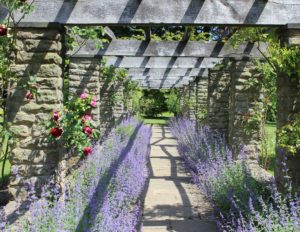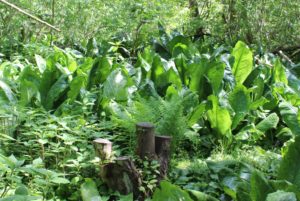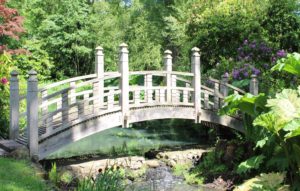I had not heard of this place until my U3A photography group planned a visit. I was unable to go, but my daughter and family live in Birmingham and she suggested we met up at the gardens so I could do some photographs, ready to show at the next U3A meeting.
My daughter was familiar with the place as she works in the nearby University of Birmingham, and Winterborne has been owned by the University since 1944. Renowned for its botanical gardens, it was used as a teaching facility, the top floor of the house is in use now as a venue for conferences and meetings. The house and gardens are now open to the public.
Winterbourne is an example of an early 20th century suburban villa and gardens. It has been restored to its Edwardian Art and Craft splendour, with marvellous wallpaper and textiles ( costumes and bedspread in particular). It was built in 1903 for the Nettlefold family, whose wealth came from the manufacture of nuts and bolts – something of beauty created from the making of such mundane objects! They had a large family, although two children died young and their lives are shown through the various rooms of the house- all with photos, family information and artefacts. I particularly liked the nursery, full of toys and childrens furniture; and the kitchen, showing were the servants worked
The gardens cover 7 acres and display plants from around the world- over 6,000 species (many labelled), ranging from huge leaved bog loving plants to tiny alpines. There is a woodland walk, a Japanese style bridge, a hazelnut tunnel and a variety of herbaceous borders and lawns. Several greenhouses are full of exotically shaped cactus plants, and there are vegetables and fruit bushes too. The garden has been planted by enthusiasts and has been evolving for over 100 years. It has fascinating little areas, with pathways leading from one area to another, some straight and formal, others winding. Some areas are reached through narrow entrances, like doors, framed with leaves.
As well as the gardens and house there is a small art gallery, an artist in residence (only open two days a week), a room with a printing press, a gift shop, plant sales and second hand books.
There is an excellent tea room, with terrace overlooking the gardens where you can sit and enjoy your refreshments.
It is a very relaxing, gentile place. There are a lot of garden seats, so stroll and sit and admire. I was amused to see one elderly couple on a bench inside a glass house, enjoying a quiet read of their newspapers! Not very child orientated though, other than a train set that they could activate by buttons, in the house, and child portions and colouring sheets in the tea room. Nothing fun or educational, it was very much a place for grownups to enjoy. My grandchildren are 6 and 3 years old, so could not wander off to explore by themselves, and got a bit bored. There is a programme of interesting events throughout the year, only Octobers look child friendly though.
There is access for mobility scooters, wheelchairs, and pushchairs for most of the garden. Manual wheelchairs can access the house, where there is a lift to the upper floor. No pushchairs are allowed in the tea room, or house.
It is not so well known as National Trust properties, but similar in style and well worth a visit.










